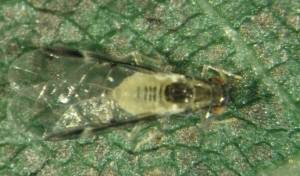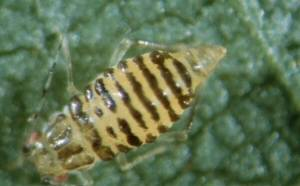Blackmargined Aphid
 Scientific Name
Scientific Name
Monellia caryella
Host
Found on pecan and hickory.
Symptoms
Similar to the yellow pecan aphid, the most noticeable damage caused by blackmargined aphids is their deposits of honeydew on the foliage. Honeydew is a sticky fluid excreted by aphids, and it supports the growth of sooty mold fungi. This fungus reduces the amount of sunlight reaching the photosynthetic cells of the leaflets. Heavy spring infestations can injure a tree's vascular system and reduce chlorophyll development and leaflet size. Some studies show aphids also impair overall tree growth. Heavy late summer infestations can defoliate trees.
Life Cycle

Description
All forms of the blackmargined aphid have a yellow or pale yellow background color. (They are often called yellow aphids.) The most noticeable marking is a heavy black margin along the front edge of the front wings and on the edge of the head and thorax in winged forms. Early spring forms may not exhibit the distinct markings. The wings are held flattened above the body when they are at rest. Fall female forms have dark bands across most segments of the body.
Control
Please contact your local county extension office for current information.

